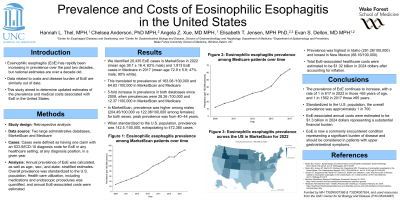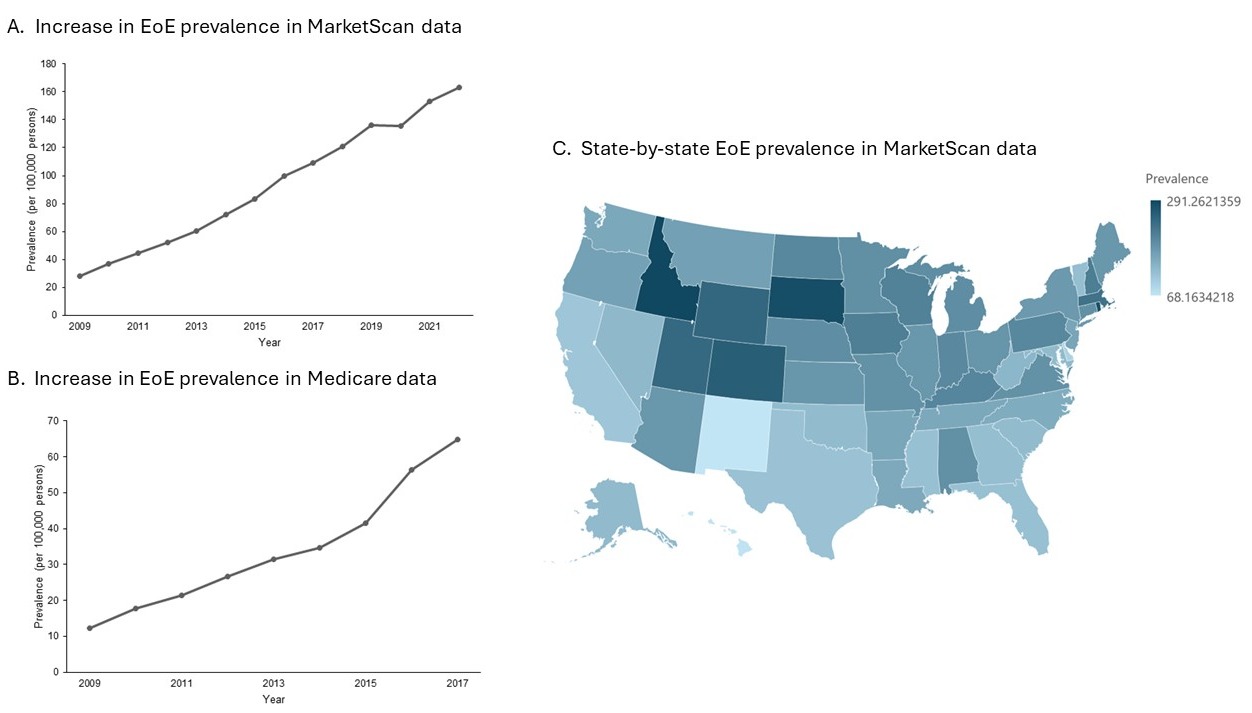Monday Poster Session
Category: Esophagus
P2224 - Prevalence and Costs of Eosinophilic Esophagitis in the United States
Monday, October 28, 2024
10:30 AM - 4:00 PM ET
Location: Exhibit Hall E

Has Audio
- HT
Hannah L. Thel, BS
University of North Carolina at Chapel Hill School of Medicine
Chapel Hill, NC
Presenting Author(s)
Hannah L. Thel, BS1, Chelsea Anderson, PhD, MPH2, Angela Z. Xue, MD, MPH1, Elizabeth T. Jensen, MPH, PhD3, Evan S.. Dellon, MD, MPH, FACG1
1University of North Carolina at Chapel Hill School of Medicine, Chapel Hill, NC; 2University of North Carolina, Chapel Hill, NC; 3Wake Forest University School of Medicine, Pfafftown, NC
Introduction: Eosinophilic esophagitis (EoE) has rapidly been increasing in prevalence over the past two decades, but national estimates are over a decade old. Data related to costs and disease burden of EoE are similarly out of date. We aimed to determine updated estimates of the prevalence and medical costs associated with EoE in the United States.
Methods: We used two large administrative databases, MarketScan and Medicare, and International Classification of Disease-9 and -10 codes (530.13; K20.0) to calculate annual prevalence of EoE, as well as age-, sex-, and state- stratified estimates. Overall prevalence was standardized to the U.S. population. Health care utilization, including medications and endoscopic procedures was quantified, and annual EoE-associated costs were estimated.
Results: We identified 20,435 EoE cases in MarketScan in 2022 (mean age 38.1 ± 16.4; 62% male) and 1,913 EoE cases in Medicare in 2017 (mean age 72.9 ± 5.9; 47% male; 90% white). This translated to prevalences of 163.08 cases/100,000 and 64.83 cases/100,000 in MarketScan and Medicare, respectively. There was a 5-fold increase in prevalence in both databases since 2009, when prevalences were 28.26 cases/100,000 and 12.37 cases/100,000 in MarketScan and Medicare, respectively (Figures 1A and 1B). In MarketScan, prevalence was higher among males (204.45/100,000 vs 122.06/100,000 among females); for both sexes, peak prevalence was from 40–44 years. There was variability in prevalence by state (Figure 1C). Prevalence was highest in Idaho (291.26/100,000) and lowest in New Mexico (68.16/100,000). When most recently available annual prevalences were standardized to the U.S. population, the prevalence of EoE was 142.5 cases/100,000, extrapolating to 472,380 cases. Total EoE-associated healthcare costs were estimated to be $1.32 billion in 2024 dollars after accounting for inflation.
Discussion: The prevalence of EoE continues to increase, with a rate of 1 in 617 in 2022 in those < 65 years of age, and 1 in 1562 in 2017 those ≥65 years. Standardized to the U.S. population, the overall prevalence was approximately 1 in 700. EoE-associated annual costs were estimated to be $1.3 billion in 2024 dollars representing a substantial financial burden. Given the dramatic 5-fold increase in prevalence since 2009, EoE is now a commonly encountered condition representing a significant burden of disease and should be considered in patients with upper gastrointestinal symptoms.

Disclosures:
Hannah L. Thel, BS1, Chelsea Anderson, PhD, MPH2, Angela Z. Xue, MD, MPH1, Elizabeth T. Jensen, MPH, PhD3, Evan S.. Dellon, MD, MPH, FACG1. P2224 - Prevalence and Costs of Eosinophilic Esophagitis in the United States, ACG 2024 Annual Scientific Meeting Abstracts. Philadelphia, PA: American College of Gastroenterology.
1University of North Carolina at Chapel Hill School of Medicine, Chapel Hill, NC; 2University of North Carolina, Chapel Hill, NC; 3Wake Forest University School of Medicine, Pfafftown, NC
Introduction: Eosinophilic esophagitis (EoE) has rapidly been increasing in prevalence over the past two decades, but national estimates are over a decade old. Data related to costs and disease burden of EoE are similarly out of date. We aimed to determine updated estimates of the prevalence and medical costs associated with EoE in the United States.
Methods: We used two large administrative databases, MarketScan and Medicare, and International Classification of Disease-9 and -10 codes (530.13; K20.0) to calculate annual prevalence of EoE, as well as age-, sex-, and state- stratified estimates. Overall prevalence was standardized to the U.S. population. Health care utilization, including medications and endoscopic procedures was quantified, and annual EoE-associated costs were estimated.
Results: We identified 20,435 EoE cases in MarketScan in 2022 (mean age 38.1 ± 16.4; 62% male) and 1,913 EoE cases in Medicare in 2017 (mean age 72.9 ± 5.9; 47% male; 90% white). This translated to prevalences of 163.08 cases/100,000 and 64.83 cases/100,000 in MarketScan and Medicare, respectively. There was a 5-fold increase in prevalence in both databases since 2009, when prevalences were 28.26 cases/100,000 and 12.37 cases/100,000 in MarketScan and Medicare, respectively (Figures 1A and 1B). In MarketScan, prevalence was higher among males (204.45/100,000 vs 122.06/100,000 among females); for both sexes, peak prevalence was from 40–44 years. There was variability in prevalence by state (Figure 1C). Prevalence was highest in Idaho (291.26/100,000) and lowest in New Mexico (68.16/100,000). When most recently available annual prevalences were standardized to the U.S. population, the prevalence of EoE was 142.5 cases/100,000, extrapolating to 472,380 cases. Total EoE-associated healthcare costs were estimated to be $1.32 billion in 2024 dollars after accounting for inflation.
Discussion: The prevalence of EoE continues to increase, with a rate of 1 in 617 in 2022 in those < 65 years of age, and 1 in 1562 in 2017 those ≥65 years. Standardized to the U.S. population, the overall prevalence was approximately 1 in 700. EoE-associated annual costs were estimated to be $1.3 billion in 2024 dollars representing a substantial financial burden. Given the dramatic 5-fold increase in prevalence since 2009, EoE is now a commonly encountered condition representing a significant burden of disease and should be considered in patients with upper gastrointestinal symptoms.

Figure: Figure
Disclosures:
Hannah Thel indicated no relevant financial relationships.
Chelsea Anderson indicated no relevant financial relationships.
Angela Xue indicated no relevant financial relationships.
Elizabeth Jensen: Jazz Pharmaceuticals – Consultant. Regeneron – Advisory Committee/Board Member, Consultant. TARGET-RWE – Advisory Committee/Board Member, Grant/Research Support.
Evan Dellon: Abbott – Consultant. AbbVie – Consultant. Adare/Ellodi – Consultant, Grant/Research Support. Aimmune – Consultant. Akesobio – Consultant. Alfasigma – Consultant. ALK – Consultant. Allakos – Consultant, Grant/Research Support. Amgen – Consultant. Aqilion – Consultant, Grant/Research Support. Arena/Pfizer – Consultant, Grant/Research Support. Aslan – Consultant. AstraZeneca – Consultant, Grant/Research Support. Avir – Consultant. Biorasi – Consultant. Calypso – Consultant. Celgene/Receptos/BMS – Consultant, Grant/Research Support. Celldex – Consultant. Dr. Falk Pharma – Consultant. Eli Lilly – Consultant. EsoCap – Consultant. Eupraxia – Consultant, Grant/Research Support. Ferring – Consultant, Grant/Research Support. GlaxoSmithKline – Consultant, Grant/Research Support. Gossamer Bio – Consultant. Holoclara – Consultant. Holoclara – Grant/Research Support. Invea – Consultant. Invea – Grant/Research Support. Knightpoint – Consultant. Landos – Consultant. LucidDx – Consultant. Meritage – Grant/Research Support. Miraca – Grant/Research Support. Morphic – Consultant. Nexstone Immunology/Uniquity – Consultant. Nutricia – Consultant, Grant/Research Support. Parexel/Calyx – Consultant. Phathom – Consultant. Regeneron Pharmaceuticals Inc. – Consultant, Grant/Research Support. Revolo – Consultant, Grant/Research Support. Robarts/Alimentiv – Consultant. Salix – Consultant. Sanofi – Consultant. Shire/Takeda – Consultant, Grant/Research Support. Target RWE – Consultant. Upstream Bio – Consultant.
Hannah L. Thel, BS1, Chelsea Anderson, PhD, MPH2, Angela Z. Xue, MD, MPH1, Elizabeth T. Jensen, MPH, PhD3, Evan S.. Dellon, MD, MPH, FACG1. P2224 - Prevalence and Costs of Eosinophilic Esophagitis in the United States, ACG 2024 Annual Scientific Meeting Abstracts. Philadelphia, PA: American College of Gastroenterology.
